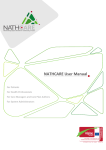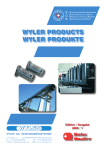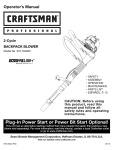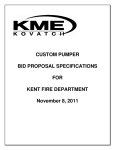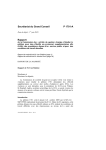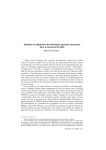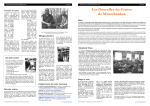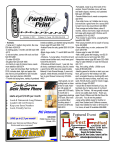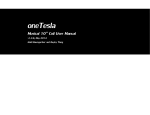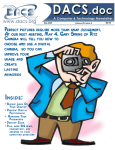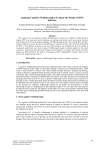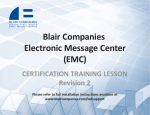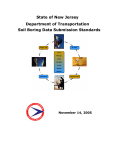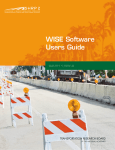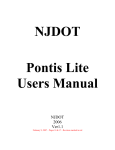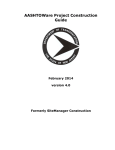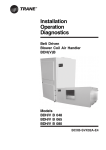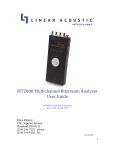Download Manual of Guidelines for Inspection of ITS Equipment and Facilities
Transcript
FHWA-NJ-2008-006 Manual of Guidelines for Inspection of ITS Equipment and Facilities FINAL REPORT September 2008 Submitted by Dr. Kaan Ozbay Professor Center for Advanced Infrastructure and Transportation (CAIT) Civil and Env. Engineering Rutgers University Eren Erman Ozguven Research Assistant Center for Advanced Infrastructure and Transportation (CAIT) Civil and Env. Engineering Rutgers University Tolga Sertel Software Engineer Center for Advanced Infrastructure and Transportation (CAIT) Civil and Env. Engineering Rutgers University NJDOT Research Project Manager Nazhat Aboobaker, Ph.D., P.E. In cooperation with New Jersey Department of Transportation Bureau of Research And U.S. Department of Transportation Federal Highway Administration DISCLAIMER STATEMENT "The contents of this report reflect the views of the author(s) who is (are) responsible for the facts and the accuracy of the data presented herein. The contents do not necessarily reflect the official views or policies of the New Jersey Department of Transportation or the Federal Highway Administration. This report does not constitute a standard, specification, or regulation." The contents of this report reflect the views of the authors, who are responsible for the facts and the accuracy of the information presented herein. This document is disseminated under the sponsorship of the Department of Transportation, University Transportation Centers Program, in the interest of information exchange. The U.S. Government assumes no liability for the contents or use thereof. TECHNICAL REPORT STANDART TITLE PAGE 1. Report No. FHWA-NJ-2008-006 2. Government Accession No. 4. Title and Subtitle FINAL REPORT Manual of Guidelines for Inspection of ITS Equipment and Facilities 7. Author(s) 3. R ecipi ent’ s Ca tal og N o. 5. R ep or t Da t e September 2008 6. Performing Organization Code CAIT/Rutgers University 8. Performing Organization Report No. Ozbay, Kaan Ph. D., Ozguven, Eren Erman, and Tolga Sertel 9. Performing Organization Name and Address Rutgers University 100 Brett Road Piscataway, NJ 08854 FHWA-NJ-2008-006 10. Work Unit No. 11. Contract or Grant No. 13. Type of Report and Period Covered 12. Sponsoring Agency Name and Address New Jersey Department of Transportation PO 600 Trenton, NJ 08625 Federal Highway Administration U.S. Department of Transportation Washington, D.C. Final Report 01/01/07 - 08/31/08 14. Sponsoring Agency Code 15. Supplementary Notes 16. Abstract ITS acceptance and maintenance inspection manual is needed as a reference document to assist the Department's inspectors, ITS design and traffic operations and ITS maintenance personnel to ensure effective inspection and maintenance of ITS facilities. This manual should be a comprehensive reference document that has separate inspection (acceptance) and maintenance sections. Inspection (acceptance) section should definitely cover the following areas (but should not be limited to these only): • Inspection of ITS equipments after the installation, • Acceptance testing, • Verifying that the corresponding ITS equipment and its elements have been manufactured and constructed in accordance to the quality requirements of the specifications/plans. Maintenance sections will cover the following areas (but should not be limited to these only): • Routine maintenance of various ITS equipment including, • Maintenance schedules for ITS systems and devices, • Troubleshooting, spare parts inventory, configuration management and disaster recovery, etc. A wide variety of engineers including civil, mechanical, electrical, software and computer, and communication engineers, are required to design and construct ITS facilities. ITS device manufacturers, system vendors, suppliers, and contractors, etc., develop and provide drawings, guides, manuals, inspection procedures, maintenance procedures. Thus, there is a vast amount of knowledge that is needed to be extracted and then incorporated into a Manual of Guidelines for effective Inspection of ITS facilities by knowledgeable, experienced NJDOT personnel and well-trained inspectors and/or subcontractors. The major goal of this project is to provide these stakeholders with the tools necessary to effectively inspect and maintain New Jersey’s ITS equipments. 17. Key Words Intelligent Transportation Systems, Inspection, Acceptance, Maintenance, Troubleshooting. 19. Security Classif (of this report) Unclassified Form DOT F 1700.7 (8-69) 18. Distribution Statement 20. Security Classif. (of this page) Unclassified 21. No. of Pages 83 22. Price ACKNOWLEDGMENTS The authors wish to thank various staff members without whom this rewrite would not have been possible. We thank Nazhat Aboobaker of the New Jersey Department of Transportation (NJDOT) for her invaluable contributions to the success of this project from its inception to completion of the final report. We also thank Tim Bourne, Tiberiu Tajts, and Edward Hanna. At each step of the project, they provided the project team with timely advice that significantly enhanced the quality of the final product. We also thank the interviewees. The project would not have been completed without the cooperation of the survey respondents and interview participants who graciously contributed their time and expertise to the study. This project was funded by a grant from New Jersey Department of Transportation (NJDOT), and administered through the Center for Advanced Infrastructure and Transportation (CAIT). Their support is both acknowledged and appreciated. ii TABLE OF CONTENTS Page EXECUTIVE SUMMARY ...................................................................................... 1 INTRODUCTION .................................................................................................. 3 RESEARCH METHODOLOGY ............................................................................ 4 KNOWLEDGE ACQUISITION THROUGH SURVEYS AND INTERVIEWS ........ 5 Traditional Literature Review ......................................................................... 5 Well-Structured Expert Surveys/Interviews .................................................. 6 Generic Surveys .......................................................................................... 8 Expert Interviews ......................................................................................... 9 NJDOT Personnel and Contractors ........................................................ 9 Industry Representatives (Orth-Rodgers and Associates, Inc. (ORA)), and Agencies from Other States .......................................................... 10 KNOWLEDGE ELUCIDATION .......................................................................... 10 Summary of Literature Review Results ...................................................... 10 Summary of Expert Survey and Interview Results .................................... 11 Summary of Meetings with Industry Representatives (Orth-Rodgers and Associates, Inc. (ORA)), and Agencies from Other States ........................ 12 KNOWLEDGE REPRESENTATION .................................................................. 12 Development of Manual Guidelines and Sections ..................................... 12 Inspection Procedures ................................................................................. 18 Physical Inspection/Maintenance ............................................................ 18 Maintenance Procedures ............................................................................. 19 Troubleshooting............................................................................................ 24 VALIDATION AND VERIFICATION ................................................................... 25 RUTGERS ITS INSPECTION AND MAINTENANCE SOFTWARE (RITSIMS) . 25 Description .................................................................................................... 25 Introduction ............................................................................................... 25 System Requirements and Installation.................................................... 25 Functionalities ........................................................................................... 25 iii User Details ............................................................................................ 25 Equipment Selection ............................................................................. 26 Option Selection .................................................................................... 26 Location Selection ................................................................................. 26 First History Information ....................................................................... 26 Component and Option Selection ........................................................ 26 General Information ............................................................................... 26 Inspection and Maintenance Questions .............................................. 26 Report ..................................................................................................... 27 Printable PDF Version of the Manual ................................................... 27 Pausing ................................................................................................... 27 Database Synchronization .................................................................... 27 History and Queries ............................................................................... 28 Work Flow and Structure of RITSIMS Using ITSIMM ................................. 28 Description of the Database Structure of RITSIMS .................................... 31 Feedback and Debugging ............................................................................ 31 Feedback from NJDOT Personnel............................................................ 32 Feedback from Orth-Rodgers Meetings .................................................. 32 First-Level Testing of the Content and the Software.............................. 32 User Manual .................................................................................................. 33 Training .......................................................................................................... 33 CONCLUSIONS AND RECOMMENDATIONS .................................................. 34 REFERENCES ................................................................................................... 35 APPENDIX A. – ITS ELEMENTS AND TECHNOLOGIES ................................ 37 CLOSED CIRCUIT TELEVISION CAMERAS (CCTV) ....................................... 37 VARIABLE MESSAGE SIGNS (VMS) ............................................................... 37 ROADWAY INFORMATION SYSTEMS ............................................................ 37 Highway Advisory Radio (HAR) and Radio-Data Systems (RDS) ............. 37 Weather Stations and Sensors .................................................................... 38 Customer Connection (Service) Boxes ....................................................... 38 iv WIRELINE & WIRELESS COMMUNICATION AND DISTRIBUTION SYSTEMS ........................................................................................................................... 38 TRAFFIC SENSORS AND DETECTORS .......................................................... 39 Inductive Loop Detectors ............................................................................. 39 Magnetic Sensors ......................................................................................... 39 Microwave Radar Sensors ........................................................................... 39 Infrared Sensors ........................................................................................... 39 Ultrasonic Sensors ....................................................................................... 40 Acoustic Sensors.......................................................................................... 40 Video Image Processing .............................................................................. 40 APPENDIX B.1. – INTERVIEW CONTACT LIST............................................... 41 APPENDIX B.2. – SAMPLE QUESTIONNAIRE ................................................ 42 APPENDIX C.1. – PENNSYLVANIA TURNPIKE AUTHORITY MEETING RESULTS ........................................................................................................... 51 APPENDIX C.2 – DELAWARE DEPARTMENT OF TRANSPORTATION MEETING RESULTS ......................................................................................... 52 APPENDIX D – INSPECTION CHECKLISTS .................................................... 53 APPENDIX E.1 – MAINTENANCE GENERIC CHECKLISTS ........................... 53 APPENDIX E.2 – MAINTENANCE BRAND SPECIFIC CHECKLISTS ............. 53 APPENDIX E.3 – MAINTENANCE CHECKLISTS FOR COMMON EQUIPMENT ........................................................................................................................... 53 APPENDIX F.1 – GENERIC TROUBLESHOOTING TABLES .......................... 53 APPENDIX F.2 – BRAND SPECIFIC TROUBLESHOOTING TABLES ............ 53 APPENDIX G – DATABASE TABLES .............................................................. 55 APPENDIX H– RITSIMS USER MANUAL ......................................................... 60 v LIST OF FIGURES Page Figure 1. Stakeholder Groups (16) .............................................................................. 7 Figure 2. Overall Approach for Collecting Expert/Stakeholder Information (16) .......... 8 Figure 3. Basic Components of ITS Manual Guidelines ............................................ 13 Figure 4. Five Categories of ITS Equipment .............................................................. 14 Figure 5. Procedural Flowchart for Inspection, Maintenance, and Troubleshooting of ITS Equipment .................................................................................................... 15 Figure 6. Methodology for Development of ITS Manual............................................. 17 Figure 7. Basic Components of ITS Maintenance Activity ......................................... 20 Figure 8. Basic Approaches for Performing Preventive Maintenance ........................ 21 Figure 9. Sample Maintenance Checklist .................................................................. 23 Figure 10. ITS Inspection and Maintenance Manual (ITSIMM) Work Flow and Structure ............................................................................................................. 29 Figure 11. ITS Inspection and Maintenance Manual (ITSIMM) Concept Map ........... 30 Figure 12. Database Diagram .................................................................................... 31 LIST OF TABLES Page Table 1 - Field Definitions for User Database ............................................................ 55 Table 2 - Field Definitions for Location Database ...................................................... 55 Table 3 - Field Definitions for Inspection Database ................................................... 56 Table 4 - Field Definitions for Maintenance Database ............................................... 57 Table 5 - Field Definitions for Troubleshooting Database .......................................... 58 Table 6 - Field Definitions for Abbreviations Database .............................................. 58 Table 7 - Field Definitions for Checklist Questions Database .................................... 59 vi EXECUTIVE SUMMARY Due to the extensive and highly developed roadway infrastructure of New Jersey, which carries heavy traffic of cars and trucks, intelligent transportation systems (ITS) play a pivotal role in ensuring mobility. Technology, in the form of ITS, offers a valuable tool to improve the operations and management of our existing transportation facilities. ITS consist of a wide range of electronic devices and communication technologies that ensure the most efficient utilization of surface transportation systems. ITS play a vital role in ensuring increased efficiency and connectivity of the State’s highway transportation system, which continues to evolve in order to respond to the challenges of an economically vibrant State such as New Jersey. Thus, given the highdensity growth of the region, it is important to ensure that deployed ITS equipment works properly and efficiently. Central to this objective is the need for new tools that will provide the State with complete, practical, and efficient acceptance and/or inspection procedures for the proper installation and preventive and/or routine maintenance of its ITS equipment. The principal motivation of this study is to provide the New Jersey Department of Transportation (NJDOT) with a state-of-the-art and practical ITS inspection (acceptance) and maintenance manual (ITSIMM). This manual is needed as a reference document to assist the department’s inspectors and maintenance personnel and ITS design and traffic operations personnel to ensure effective inspection and maintenance of NJDOT’s ITS equipment. A wide variety of engineers—including civil, mechanical, electrical, software and computer, and communication engineers—are required to design and construct ITS facilities. ITS device manufacturers, system vendors, suppliers, and contractors develop and provide drawings, guides, manuals, inspection procedures, and maintenance procedures. Thus, a vast amount of knowledge must be extracted and then incorporated into a manual of guidelines for effective inspection and maintenance of ITS equipment by knowledgeable, experienced NJDOT personnel and well-trained inspectors and subcontractors. The major goal of this project is to provide these stakeholders with the tools necessary to inspect and maintain New Jersey’s ITS equipment. The four major goals of our study can be summarized as follows: 1 • Acquire the knowledge and experience related to the maintenance and inspection of ITS equipment that reside with New Jersey Department of Transportation (NJDOT) personnel, consultants, ITS device manufacturers, system vendors, suppliers, and contractors. • Compile additional information from well-structured comprehensive interviews with experts, manuals, research literature, other DOTs, FHWA, related web sites, and manufacturers’ published material. • Develop a state-of-the-art inspection and maintenance manual (ITSIMM) in the form of checklists composed of inspection and maintenance questions for a wide variety of ITS equipment. • Develop a computer tool that uses the structure and knowledge base of ITSIMM to enable users to conduct efficient and careful inspection and maintenance of ITS facilities. The manual guidelines implemented in Rutgers ITS Inspection and Maintenance Software (RITSIMS) have several advantages as summarized below. • With RITSIMS, DOT personnel can easily inspect and maintain any ITS equipment with a laptop computer or a tablet PC. • Detailed information of each inspection and maintenance performed is automatically recorded in the appropriate databases. • The equipment list database includes specific details for the selected ITS equipment, such as location, age, and inspection details. • A troubleshooting option enhances the on-site process of solving simple yet frequently encountered equipment-related problems. • At any time, it is possible to add or delete equipment items and questions. ITSIMM and the computer-based tool RITSIMS, developed by the Rutgers research team, are expected to improve the effectiveness of NJDOT personnel in the field. Moreover the state-of-the-art knowledge compiled in the form of a practical yet unique manual will be an important contribution to research in the area of ITS technologies. 2 INTRODUCTION As we enter the 21st century, the importance of getting the most from our existing transportation infrastructure has become increasingly clear. Budget limits, environmental concerns, and many other factors are clearly major constraints that motivate us to limit our practice of building or expanding physical infrastructure except in those areas of most critical need. Technology, in the form of intelligent transportation systems (ITS), is a valuable tool that can be employed to improve the operations and management of our existing transportation facilities. ITS consist of a wide range of electronic devices and communications that enhance efficient use of surface transportation systems. Appendix A provides information about the ITS equipment. To ensure that ITS will meet the needs of both the New Jersey Department of Transportation (NJDOT) and the traveling public, the most important issues to be considered are the acceptance and/or inspection procedures for proper installation and preventive and/or routine maintenance of ITS equipment. To achieve this important goal, a manual of guidelines that serves as a reference document to assist NJDOT personnel in the inspection and maintenance of ITS facilities was prepared. Then, a user-friendly computer program was developed based on this comprehensive manual of guidelines. This computer program will be used to improve the efficiency and effectiveness of NJDOT personnel. Rutgers University has been selected to compile information from interviews, manuals, research literature, other departments of transportation (DOTs), FHWA, related web sites (Internet), manufacturers’ publications, etc., to develop a comprehensive ITS inspection and maintenance manual (ITSIMM) for the use of NJDOT. Therefore, a literature survey was conducted to identify the experiences of other transportation agencies and the private sector. This preliminary compilation of existing research studies resulted in a review of a wide variety of reports and documents, including policies of the U.S. Department of Transportation, FHWA, the Institute of Transportation Engineers, several States (Idaho, Kentucky, Texas, Virginia, Alabama, North Carolina, Minnesota, Arizona, Oregon, Colorado, California, Florida, North Dakota, Oklahoma, Utah, Vermont, and Wisconsin) and several countries (Canada, Ireland, Wales, Scotland, and England), guidelines from the Manual on Uniform Traffic Control Devices (MUTCD), and some private sector reports. (See references 1–36.) Using the information obtained from these resources, a preliminary ITS inspection and maintenance manual (ITSIMM), including checklists for inspection and maintenance of ITS equipment, was created. Then, surveys and several meetings were conducted in order to be able to use the experience and knowledge of experts and stakeholders. The manual was revised according to the comments and suggestions obtained from these meetings and surveys. 3 Finally, the Rutgers ITS Inspection and Maintenance Software (RITSIMS) was created using the guidelines, checklists, work flow, and structure obtained based on the literature review, surveys, and expert meetings. This software was also given to engineers and experts for further debugging of the user interface. As a result, a userfriendly software (RITSIMS) that can be used efficiently by NJDOT personnel for inspection and maintenance of ITS equipment was implemented. Another important feature of RITSIMS is the capability to identify relevant checklists that can then be printed for performing the inspection and maintenance without a computer but just using hard copies. The report is divided into eight sections including the introduction: Section 2 provides a brief overview of the research methodology used to develop ITSIMM. Section 3 describes and summarizes the well-structured meetings and surveys conducted. Section 4 gives information about elucidation of the knowledge from these meetings and surveys. Section 5 explains how the manual guidelines were obtained using the knowledge representation, and Section 6 deals with the validation and verification of these guidelines with the help of experts. Section 7 explains the details of RITSIMS. Finally, Section 8 presents the results of the work as well as conclusions and recommendations. RESEARCH METHODOLOGY The main challenge in this project was to develop an effective methodology to extract knowledge from a diverse set of experts and sources. This knowledge extraction process can be achieved only by using a proven scientific methodology tested for this kind of problem. An ad hoc approach based on a series of informal interviews with several sources from the public and private sectors would fail to produce a high-quality and reliable result. The methodology used in similar projects where the problem domain is large and experts and expertise are scattered is called “knowledge base development.” There are various techniques and approaches developed by knowledge engineers who work on capturing the expert knowledge of domain experts. As our role is to define an effective process that will capture the expertise of NJDOT personnel as the main resource, we supplemented this resource with knowledge that already existed at other DOTs as well as published material from the manufacturers and suppliers of the ITS equipment to be inspected and/or maintained. Thus, we propose an intense knowledge base development process that involves the following well-known steps: 4 • • • • Step 1: Knowledge Acquisition: This step involves meeting with experts, reviewing documents in the field, and conducting site studies to acquire the knowledge to be used in developing the knowledge base necessary to produce the content for the ITSIMM, its checklists, the RITSIMS software, and the training content. Step 2: Knowledge Elucidation: This step involves processing expert knowledge to clarify different aspects of the knowledge acquired from the experts and other cited resources. Step 3: Knowledge Representation: This step consists of developing written material including the manual, the procedures, and the guidelines using the expert knowledge obtained and processed previously. Step 4: Validation and Verification of Developed Material: Most of the information in the manual will be highly technical and procedural, and it is important to verify and validate it carefully before using it. Upon the development of various products including ITSIMM, its checklists, RITSIMS software, and the training content, they are evaluated by the experts or the developers to ensure their accuracy and appropriateness for the tasks they are designed to do. Depending on the results of this step, the research team decides whether to go back to steps 1 and 2 and whether to make changes. This step must be done with problem domain experts who will be able to give practical advice about any proposed procedures. KNOWLEDGE ACQUISITION THROUGH SURVEYS AND INTERVIEWS This step involves meeting with experts, reviewing related documents, and conducting site studies to acquire the knowledge necessary to develop the content of the knowledge of the manual and its software implementation. We call this part of the project “knowledge acquisition” because it is clear that the knowledge exists in several places and with a number of people in addition to information in the published literature. Thus, this step becomes a knowledge acquisition task that has to cover a large domain of knowledge between the literature and human experts. We divide this task into two steps. Traditional Literature Review This step is the comprehensive review of manuals, research literature, other DOTs’ and FHWA’s related web sites (Internet), manufacturers’ publications, etc., to develop an ITS inspection and maintenance manual (ITSIMM) for the use of NJDOT. A literature search was performed to identify the experiences of other transportation agencies as well as the private sector. This preliminary compilation of existing research studies resulted in the review of a wide variety of reports and documents including policies of the U.S. Department of Transportation, FHWA, the Institute of Transportation 5 Engineers, several States (Idaho, Kentucky, Texas, Virginia, Alabama, North Carolina, Minnesota, Arizona, Oregon, Colorado, California, Florida, North Dakota, Oklahoma, Utah, Vermont, and Wisconsin) and several countries (Canada, Ireland, Wales, Scotland, and England), the MUTCD guidelines, and some private sector reports. (See references 1–36.) Well-Structured Expert Surveys/Interviews As the involvement of experts and stakeholders is vital for developing a comprehensive and reliable ITS manual, the development of an efficient strategy for conducting wellstructured interviews with predetermined experts, practitioners, and stakeholders is an important task. (See reference 16 for details.) The surveys and interviews were prepared and conducted by the Rutgers Intelligent Transportation Systems (RITS) Laboratory according to the protocol-generation techniques aimed at recording the best inspection and maintenance practices from experienced NJDOT professionals. This step is especially important in terms of capturing the long-term knowledge of NJDOT personnel responsible for related ITS maintenance and inspection issues. The idea is presented in (16) as: “The primary objectives of the knowledge acquisition plan are as follows: • Identify potential stakeholder roles regarding ITS: Actual roles of the public, private and non-profit sectors in ITS deployment should be clearly identified. Therefore, the stakeholders can be placed in the following broad categories, which reflect their primary roles in the transportation industry: 1. Public Agencies (Department of Transportation, Municipalities, District Managers, Transportation Operation Center (TOC) Managers, etc.); 2. Commercial Organizations (Private Companies, Regional Electricians if any, etc.); 3. Industrial Organizations (Private Industries who operate their own transportation facilities and fleets, etc.); 4. Suppliers / Service Providers (Information Services who has responsibility over ITS hardware and software installations, etc); and 5. Institutional/Special Interest (Universities, Post-secondary Institutions, etc.).” Figure 1 shows the stakeholder groups. 6 Figure 1. Stakeholder S Groups (16)) As expe ected, beforre the stake eholder con nsultation prrocess, creating a data abase that includess the followiing informa ation is nece essary: ¾ S Stakeholder r name and contact, ¾ A Areas of inte erest or parrticipation, ¾ G Group class sification according to the t above scheme, s an nd ¾ M Method of ongoing com mmunication ns used (e..g., e-mail, telephone, meetings). • P Provide an efficient strategy to obtain inp put from sta akeholders s: Stakeholder input related to exis sting initiatives and isssues, current ITS deployments, and a future ments should be solicitted. requirem • Id dentify measures of success s and perform mance crite eria: Publicc sector, priivate sector, and a nonpro ofit sector orrganizations and groups have diffferent criteria for evaluatin ng the succ cess of ITS deploymen nt. Using th he input from m stakehold ders, metho ods for the success—in s n terms of efficiency e an nd effective eness—of IT TS should be identified. Another issue is tha at because e individual stakeholde ers have diffferent objecctives and e different measures m o success, a key taskk is to recog of gnize the ba asic differen nces therefore and dete ermine how w to incorpo orate them into i one me easure. • Id dentify institutional and a other barriers: b A input on Any n real and perceived p institutio onal, techno ological, operational, fiinancial, an nd other barriers mightt be useful of the ITS manual. during preparation p The ove erall approach adopted d for data gathering is shown in Figure F 2. 7 Figure 2. Overall Approach for Collecting Expert/Stakeholder Information (16) With this purpose, a few broad questions for each group of stakeholders are created: • What should the maintenance manual look like? This question is divided into several smaller questions: 1. Problem identification and verification, 2. Problem reporting and assigning, 3. Problem logging and tracking, 4. Resource allocation (equipment, staff, training, spare parts, etc.), 5. Centralized or distributed system, and 6. Prioritization (preventive versus repair). • Where does your responsibility for ITS maintenance begin and end? It is really important to determine how stakeholders think lines of responsibility should fall. • What are your top three ITS maintenance priorities? • What would you hope for the ITS maintenance manual to accomplish? Generic Surveys The first stage of knowledge acquisition consists of sending preliminary surveys and receiving answers. A stakeholder database is created for survey participants, and the survey is sent to a number of experts and stakeholders determined in close collaboration with NJDOT project contacts. The preliminary survey includes two sections: 1. General Questions/Information: Recipients are asked identification questions and basic questions about the their involvement in ITS. 8 2. ITS Specific Questions: Then, detailed questions, related to ITS inspection and maintenance, are asked. The survey participants were identified by Tim Bourne of Traffic Operations North as personnel highly experienced in inspection and/or maintenance of ITS components. Expert Interviews NJDOT Personnel and Contractors The interviewees were identified by Tim Bourne of New Jersey Traffic Operations North (NJDOT) as personnel highly experienced in inspection and/or maintenance of ITS components. The second stage includes face-to-face interviews. One-on-one interviews with experienced personnel are an important facet of our research methodology. The participants’ answers to the survey questions before the face-to-face interviews familiarized the team with the job duties of each interviewee as well as the work experience and areas of expertise of each one. This information also allowed the interviewer to tailor questions to the interviewee’s specific expertise, which maximizes the effectiveness of the interview process and minimizes the time it takes to conduct each interview. A couple of meetings have been conducted with the NJDOT project contacts to have a more accurate and efficient way of understanding the department’s ITS and problems. The meetings serve mainly as a means of gathering specific information about the current state of practice of the inspection and maintenance process of ITS equipment in New Jersey. Therefore, these meetings included the following: 1. Discussion of the structure and content of the planned interviews with NJDOT, and 2. Discussion of follow-up questions to answer some of the details of the ITS maintenance and inspection questions that were planned for inclusion in the interviews. After these two meetings, all the information obtained was processed and formalized in a written format. Moreover, other meetings were arranged to discuss the results of the research efforts so far, to concentrate on major issues, to work on specific cases, and to obtain a consensus for the next stages of ITSIMM. 9 Industry Representatives (Orth-Rodgers and Associates, Inc. (ORA)), and Agencies from Other States Orth-Rodgers and Associates, Inc. (ORA) conducted several meetings with engineers and experts in their company and with representatives of transportation agencies in other states. These meetings provided valuable feedback on the manual. As part of this effort, two meetings were handled by ORA with the Pennsylvania Turnpike Authority and the Delaware Department of Transportation. Attendees were asked to review the material provided and to submit comments and suggestions back to ORA. ORA followed up with a meeting or phone contact to solicit comments and recommendations. Main points about the manual following these meetings are presented in Appendix B. Several additional working meetings were also held with ORA to present and discuss the manual questions and content. Based on this input, several changes were made to the manual. KNOWLEDGE ELUCIDATION This step involves processing expert knowledge to clarify different aspects of the information acquired from experts and other cited resources. Summary of Literature Review Results First, there is not one commonly accepted comprehensive inspection and acceptance manual for ITS. The literature mostly includes design, installation, and operation manuals or details for ITS equipment. However, some partial manuals exist in some states—for example, the one in North Carolina has checklists for variable message signs (3) and the one in Alabama has maintenance check specifications for portable changeable message signs (14). Dudek et al. (9–11) conducted several studies for the operation and improvement of variable message signs. Working papers published by universities for the improvement of ITS facilities for a specific region also are important in determining the basic concepts of ITS inspection and maintenance procedures. (see San Joaquin Valley, Tahoe Gateway Counties, Manitoba, and Northeastern Illinois ITS development working papers (18–25).) Moreover, the ITS Primer published by the Institute of Transportation Engineers provides valuable information about ITS equipment, functions, and components (28). The most comprehensive documents for the inspection and maintenance of ITS equipment are the Traffic Control System Operations Handbook published by the Institute of Transportation Engineers (29) and the Testing Handbook for Transportation Management Systems published by TransCore. These handbooks present a general tutorial to familiarize manual users with fundamental concepts for inspecting and maintaining ITS equipment. There are also maintenance checklists for ITS equipment published by the manufacturers, departments, and subcontractors (33–36). Edwards and Kelcey have maintenance checklists with rating systems (32). The manufacturers also have checklists 10 that may not be applied for other brands of the same equipment as they are mostly equipment specific. Summary of Expert Survey and Interview Results A sample questionnaire and list of expert interviews performed are shown in Appendix B. The surveys and interviews provided significant information used in the development of ITSIMM. Experts who were interviewed provided a number of comments and problem-specific information to each section of the preliminary inspection and maintenance checklists prepared as part of our well-structured knowledge acquisition process. The most significant parts of these contributions can be listed as follows: 1. There is a need to develop an electronic data display and collection system for the inspection and maintenance of ITS equipment. This software application can be implemented on a touch-screen “tablet” notebook computer and can be used to access a database for equipment types, locations, etc. 2. The manual should work as a uniform and consistent guide to the installation, inspection, and maintenance of ITS facilities. 3. There is a need for a rating system for the maintenance questions. On the other hand, the inspection checklist can be in the form of pass/fail questions. 4. A detailed explanation for each question is not necessary. The questions in their current format are adequate. As suggested, the action item should be only made to inform the operations or maintenance center most of the time. 5. There is a need to separate maintenance procedures into different sections— namely, preventive and routine maintenance. 6. A preconstruction inspection checklist should be added to the inspection guidelines, which will provide the engineer or inspector with the ability to check the design with the existing site conditions. 7. Several questions are deleted because they are unnecessary. 8. Several questions are added/revised by the interviewers. 9. Traffic signals and signs are excluded from the manual as they are determined to be outside the scope of an ITS manual. 10. The brand-specific checklists may not be necessary as manufacturers’ specifications and manuals are already being used by the department. 11. The maintenance checklists for specific/common components of ITS equipment are relevant to the scope of the manual. 12. The communications and distribution systems are combined under one umbrella for ease of application. 13. Customer connection/service box checklists are added to the manual. The general idea is that there is a need to develop software for performing inspection and maintenance operations on a touch-screen “tablet” notebook computer. 11 Another important point is that maintenance crews are mostly small compared with the amount of equipment located over a large geographic area. Therefore, NJDOT personnel can use their time and resources more efficiently and effectively if they have a computerized version of ITSIMM—namely, RITSIMS software. Current procedures for reporting are that the operations staff check the operation of each piece of equipment frequently. Then, a written report is generated and given to the shift supervisor, who enters problems into a database; an electronic form is generated from the database and distributed to management and supervision. RITSIMS can solve this need for better reporting options. Summary of Meetings with Industry Representatives (Orth-Rodgers and Associates, Inc. (ORA)), and Agencies from Other States One of the more general outcomes of the interviews is that ITSIMM will serve as a guideline for NJDOT inspection and maintenance personnel. The interviewees agreed on the proposed structured breakdown of the overall process into preinspection (design phase), construction inspection, preventive maintenance, and troubleshooting subprocesses. The main points regarding the manual following these meetings are presented in Appendix C. On the basis of this input, several changes have been made to the manual. 1. Failure reports are added at the end of inspection and maintenance procedures for any equipment. 2. A table of contents is added to the manual. The concerns about warranty, factory testing information, a record of spare parts, and frequency and cost-related issues will be included in later versions of the manual, after the successful deployment of the proposed version of this tool and based on NJDOT’s feedback on its usage under real-world conditions. KNOWLEDGE REPRESENTATION This task is completed through the development of written material, including manuals, procedures, guidelines, etc., using the expert knowledge obtained and processed in the previous stage. Development of Manual Guidelines and Sections ITSIMM will assist NJDOT personnel in efficiently conducting inspection and maintenance of ITS technologies including closed-circuit television cameras (CCTV), 12 variable/dynamic/changeable message signs, roadway information systems (highway advisory radios, radio information systems, weather stations, customer service boxes), traffic detectors and sensors, and wireless and wireline communication and distribution systems. Moreover, the manual is designed in a way that is easy for NJDOT personnel to comprehend and use. The manual is divided into three main sections: delivery (acceptance) inspection, maintenance, and troubleshooting for ITS equipment, as shown in Figure 3. These procedures are defined and briefly explained in the next sections. ITS Manual Guidelines Delivery Maintenance (Acceptance) (Preventive & Inspection Routine) Troubleshooting Figure 3. Basic Components of ITS Manual Guidelines The ITS equipment is divided into five basic categories depending on its functions and usage as shown in Figure 4. For all the equipment categories, the above guidelines of inspection, maintenance, and troubleshooting are given throughout the manual report. 13 ITS Equipment Variable Traffic Message Signs Sensors & (VMS) Detectors Closed Circuit Roadway Wireline & Wireless Television Information Communication and Cameras (CCTV) Systems Distribution Systems Figure 4. Five Categories of ITS Equipment The inspection and maintenance procedures for ITS equipment categories are illustrated by the flowchart in Figure 5. The idea of the inspection checklist is to determine the criteria that fail for the ITS equipment that is being inspected. In other words, this is a binary pass/fail rating system that focuses on the success of the list of criteria determined for each piece of ITS equipment. Therefore, the complete satisfaction of the acceptance/inspection criteria is the most important. On the other hand, for maintenance operations, there is a rating system for all questions on the checklist. That is, action (minor or major) should be taken according to the degree of maintenance required. This concept of rating the current condition of ITS equipment is used on all the maintenance checklists. 14 Check the items given in the list INSPECTION for the selected equipment Does the Reject and check equipment satisfy again for the No the inspection requirements to be criteria? satisfied Yes Every requirement is Accept the ITS satisfied equipment Conduct the routine preventive MAINTENANCE & maintenance checks TROUBLESHOOTING Determine the degree of Does the ITS maintenance No equipment Troubleshooting required satisfy all the Major checklist Minor questions? Perform the minor Yes maintenance Report and make sure operations that the problem is solved Report that ITS Item works satisfactorily equipment has passed the check Figure 5. Procedural Flowchart for Inspection, Maintenance, and Troubleshooting of ITS Equipment 15 Next, brief background information about the basic ITS equipment is presented to introduce the inspection, maintenance, and troubleshooting concepts with respect to the various equipment types. The overall research methodology used in this study, starting with the literature survey, is presented in Figure 6. In this methodology, acquisition of information plays a very important role. Details and results of a number of wellstructured knowledge acquisition sessions conducted to capture the state-of-the practice that exists in the department are presented in the knowledge acquisition section. 16 Review Literature Identify Manual Identify Equipment & Contents & Sections Checklists Interview Experts No, update required No, update Is the manual required satisfactory in its current condition? Yes Design Software No Consult No Experts/Practitioners Yes Does the Test & Implement Software software satisfy the Train the Users work flow? Finalize the Project Figure 6. Methodology for Development of ITS Manual 17 Inspection Procedures "Inspections are designed to verify that the ITS equipment and its components are in accordance with the quality requirements of the specifications/plans. For instance, many common installation problems that arise during construction are not covered, or are only partially covered, by the design documents. That is because these problems are not anticipated in the design phase. In some cases, plans are only conceptual or they are typical designs that need to be adapted to actual site conditions." (28) Physical Inspection/Maintenance Inspection checklists have been prepared mainly to assist the project engineer and inspector(s) in performing their duties during construction. The checklists are provided as general guidelines and should be used as supplements to, not replacements for, the contract specifications and specific installation instructions of the product manufacturers and suppliers. The checklists are also intended as useful guides to designers and contractors (29). They are related to the construction of basic elements necessary for ITS equipment to work correctly and efficiently. These elements are given in (28, 29) as follows: ¾ Preconstruction Phase: A simple preconstruction check should serve for the purpose of making field modifications to the plans when necessary to fit site conditions. ¾ Conduit: A conduit is used to protect the wiring/fiber-optic cable and to facilitate installation, maintenance, and replacement of the wiring cable as required. Most conduits are rigid metal, rigid polyvinyl chloride, flexible polyethylene, or fiberglass. ¾ Junction (Pull) Box: The junction box is installed at the conduit terminal and at intermediate locations to provide access to the electrical wiring and communication cable. Materials commonly used to fabricate junction boxes include concrete, plastic, and fiberglass. ¾ Loop Detectors: Loop detectors are the most common means of vehicle detection to sense incidents, congestion, and vehicular or pedestrian demand. ¾ Foundation: The foundation is installed to support television camera poles, variable message signs, highway advisory radio antenna supports, controller cabinets, and equipment/communication cabinets. Therefore, proper location, dimensions, anchorage provisions, and workmanship are essential to ensure the structural and functional integrity of the ITS equipment. ¾ Closed-Circuit Television Camera Pole: is designed as a structural support for television cameras. ¾ Variable Message Sign Supports/Sign Box: This equipment supports the variable message signs. They can be the butterfly, cantilever, or sign bridge type. 18 ¾ Wiring and Grounding: Wiring from the communication cabinet to the ITS field components is very significant and should be done carefully. Items to be checked during installation are divided into five categories: o Preliminary wiring, o Fiber-optic cabling/splicing, o Grounding, o Final wiring, and o Wire testing. ¾ Communication/Field Equipment Cabinet: Sophisticated electronic control and communications equipment is located in environmentally controlled cabinets adjacent to busy streets and highways. ¾ Electric Service: There are many components associated with providing electric service to the field devices: o Preconstruction electric service, o Service poles and electrical feed, o Load center and meter, ¾ Traffic Maintenance During Construction: A detailed traffic control plan should be properly implemented and revised if necessary to conform to prevailing field conditions. Inspection procedure checklists in the form of pass/fail questions for the ITS elements mentioned are given in Appendix D. Maintenance Procedures ITS are often designed and installed with little attention to the future maintenance requirements. This problem has been magnified in recent years by the increasing complexity of ITS components and lack of standards. “Understaffed and underequipped maintenance departments, inadequate maintenance procedures and training, deferral of maintenance, and equipment obsolescence further compound the problem. Moreover, system maintenance is often overlooked in the life-cycle costs of an ITS system. Maintenance of a complex system can range from 10 percent to 20 percent of the development costs per year to keep the system in operation. It is significant to plan for these costs and train adequate staff to provide the services. These services can usually be provided by the developer under contract, or internal people can be trained.” (28) Maintenance practices for ITS need to address sophisticated and varied technologies including the following wireline and wireless communications and field devices: ¾ ¾ ¾ ¾ Closed-circuit television cameras (CCTV), Dynamic/variable message signs (VMS), Highway advisory radio and weather detection systems, Wireline and wireless communication and distribution systems, and 19 ¾ Traffic detectors and sensors. A summary of ITS maintenance procedures identified in this project is presented in Figure 7. ITS Maintenance Routine Preventive Spare / Backup Maintenance Maintenance Equipment Emergency Contract Maintenance Figure 7. Basic Components of ITS Maintenance Activity These five procedures are simply (28): • • Routine Maintenance: Typical daily checks, adjustments, and minor component replacement. Preventive Maintenance: Scheduled preventive maintenance performed by the agency or vendor. It is defined as a set of checks and procedures to be performed at regularly scheduled intervals for upkeep of the ITS, including maintenance inspection, record keeping, cleaning, and replacement based on the function and rated service life of each component. The preventive maintenance guidelines are provided to support the continuing operational availability of the ITS by minimizing the effects of ambient conditions and detecting and correcting for the effects of contained operation use wear and tear. There are three approaches for the preventive maintenance procedure used in the manual as shown in Figure 8. 20 Generic Approach Preventive Maintenance Approaches Brand- Common Specific Equipment Approach Approach Figure 8. Basic Approaches for Performing Preventive Maintenance These approaches are summarized below: 1. Generic Approach: General questions regardless of the equipment brand are included in this approach. For instance, if a closed circuit television system is to be checked, there are three levels to be studied separately: the pole level (upper part), the cabinet level, and the control center. Each section has its own proper checklist, and they can be checked routinely in different time intervals. 2. Brand-Specific Approach: The second approach includes specific questions for brands used by NJDOT—Daktronics, Vultron, etc. 3. Common Equipment Approach: Questions related to the equipment common to all devices belong to this category. With both approaches, there are several check points to be considered during maintenance, as shown in Appendix E. Tables in the appendices are an attempt by the research team to summarize various approaches found in the literature. In these checklists, a rating system has been applied to the inspection checklists as a result of 21 stakeholder meetings. Depending on the completion of the task, four ratings are available: ¾ ¾ ¾ ¾ Excellent: Totally operative/new Good: Operative/satisfactory Fair: Operative/needs minor work Bad: Not operative/needs major work The inspector will select one of these options depending on the condition of the ITS equipment. This rating makes it easier to assess the current status as well as future maintenance requirements of the equipment. • • • Spare/Backup Equipment: Inventory of spare and backup equipment. (Listing of suppliers, vendors, and contractor contact information (e.g., phone, pager, email) associated with equipment and software related to the system.) Emergency: Nonroutine procedures, notification of responsible party (agency or contractor), shut down. Contract Maintenance: Procedures/warrants for calling in private maintenance contractor. (Phone numbers, pager numbers, etc., of contract maintenance organizations. Topics such as agency access to records, to components (both spare and damaged), and to field/office sites could be addressed) (26). The summarized illustrative version of the maintenance procedures is given in Figure 9. 22 Sample Maintenance Checklist • • • • Closed Circuit Variable Message Road Wireline & Wireless Traffic Television Signs Information Communication and Sensors & Cameras (CCTV) (VMS-CMS-DMS) Systems Distribution Systems Detectors Camera assembly check CCTV receiver check Video streaming engine check Field equipment cabinet check • • • Make a field inspection Cabinet interior check Cabinet exterior check • • Check the audibility capacity Check the validity of the information supplied • • Check for damage Visually inspect the cables and conduit. LOOPS • • Conduct LCR meter checks Make measurements and readings using LCR and MEGGER meter PIEZO DETECTORS • • Figure 9. Sample Maintenance Checklist 23 Conduct LCR meter checks Check the asphalt and sensor for cracks Troubleshooting Based on the field experience of NJDOT engineers, it would be useful to have some common troubleshooting measures to help field personnel solve a problem that occurs during preventive or routine maintenance checks. Because trying to find the problem and its solution in the field can be difficult and time-consuming, the idea of developing a troubleshooting component has utmost importance to support efficient operation of the ITS equipment that is being maintained. To achieve this goal, troubleshooting tables for individual ITS devices have been prepared. They include some basic problems/symptoms, their possible causes, and remedial actions. The problem/symptom/remedy database is expected to grow over time when NJDOT personnel encounter new cases during their daily assignments. The troubleshooting checklists for ITS equipment are given in Appendix F. 24 VALIDATION AND VERIFICATION Most of the information in the manuals will be highly technical and procedural; therefore, it is important to verify and validate it carefully before use. Various products including ITSIMM, checklists, RITSIMS software, and training material developed as part of this project were evaluated by experts to ensure their accuracy and appropriateness for the tasks they are designed for. Depending on the results of this step, the research team decided whether to return to the knowledge acquisition and knowledge elucidation steps and whether to make changes. This step was done with problem domain experts who are capable of giving practical advice about the proposed procedures. Therefore, during and after obtaining the draft version of ITSIMM, the manual is constantly revised by experts from NJDOT, private companies, and other State agencies. Comments of experts were obtained several times for different versions of the manual to verify the efficiency and effectiveness of ITSIMM and RITSIMS. RUTGERS ITS INSPECTION AND MAINTENANCE SOFTWARE (RITSIMS) Description Introduction RITSIMS is implemented in Visual.Net language. The functionalities of RITSIMS are given in the next section, and a user manual is presented in Appendix G for illustrative details. System Requirements and Installation RITSIMS is compatible with Windows 98/2000, Windows XP, and Windows Vista. Microsoft.Net Framework 2.0 should be installed before RITSIMS installation. The application can be started by clicking on the MTSoft.exe file in the MTSoft folder. All the other database files (.mdb’s) are accessible in the same folder. Functionalities There are 13 basic parts of RITSIMS to be studied briefly: User Details This is the place where the user should select the user name and password to be able to use the other functionalities of the software. 25 Equipment Selection There are five types of equipment to be selected as mentioned before: • • • • • Closed-circuit television systems (CCTV), Variable message signs (VMS), Roadway information systems (highway advisory radios, weather stations, customer connection boxes), Wireline and wireless communication and distribution systems, and Traffic detectors. Option Selection After the equipment is selected comes the inspection or maintenance option. Troubleshooting is available at any time regardless of the equipment selection. Location Selection The equipment database includes the locations of the equipment. Therefore, through the software, the inspector can easily select the equipment from the drop-down box of locations. First History Information After selection of the equipment, it is possible to see a brief history of that equipment. For instance, one can see the inspection details of that equipment while doing maintenance for the same equipment later on. Component and Option Selection The component to be inspected can be selected for each piece of equipment separately in this section. For the inspection, selecting the component is sufficient. However, for the maintenance procedures, one should first select the maintenance options (preventive, routine, common equipment, and brand specific) and then choose among the components of the ITS equipment. General Information To make sure the correct ITS equipment is selected, all the details obtained from the above selections are summarized for further use. Inspection and Maintenance Questions Here, it is possible to answer the inspection or maintenance checklist questions for the equipment selected. One has three options for inspection: • Pass, 26 • • Fail, and Skip, if it is not applicable. Maintenance has a rating system based on three different options: • • • Completed, o Excellent: Totally operative/new o Good: Operative/satisfactory o Fair: Operative/needs minor work o Bad: Not operative/needs major work Not completed, and Skip, if it is not applicable. Report It is possible to see the detailed report obtained for inspection or maintenance done on ITS equipment. The report includes: • • • • • • Type of equipment, Type of work performed (inspection or maintenance), Inspection/maintenance date, Inspector’s name, Answers to checklist questions (answers can be changed in this report format as well; for instance, any Fail answer can be changed to Pass for the inspection, or any Not Completed question can be changed to Completed for the maintenance), and User’s comments (comments for the equipment inspected or maintained can be written here). Printable PDF Version of the Manual At any time, the checklist questions for the equipment can be printed after selecting it. This is helpful when a computer is not available for use in the field. Pausing This option is available for short-term and long-term pauses throughout the inspection and maintenance procedures. Database Synchronization The tables obtained during the inspection and maintenance procedures in the field can be sent to the master database, which is located in the main computer at the office. The synchronization can be done both ways. 27 History and Queries The history and queries (location, user, date, and equipment based) can be accessed by the supervisor, and answers to the checklist questions can be changed. Work Flow and Structure of RITSIMS Using ITSIMM With the aforementioned guidelines, a work flow and structure have been developed to make use of checklist questions. Basically, RITSIMS uses a number of databases to access the equipment lists and question checklists. The equipment list database includes specific details for the selected ITS equipment, such as location, age, and inspection details. After selection of the equipment, there are three basic choices— namely, inspection, maintenance, and troubleshooting. Upon selection of one of these choices, the generic checklists for that choice appear, and the user will be able to check the equipment and then will see the list of corresponding questions saved in the checklist database. There are also brand-specific and common element checklists, which improve the efficiency of the process. There is also a troubleshooting section, which contains a number of simple and basic sample problems and their possible causes. All the results are saved in the database of either the portable device or the main computer for future use. The overall structure of the work flow is shown in Figure 10. 28 Figure 10. ITS Inspection and Maintenance Manual (ITSIMM) Work Flow and Structure Using this work flow and structure, the concept map for ITSIMM was developed. A concept map is a graphic way of describing and capturing knowledge. That is why it is important to present such a knowledge management tool for the sake of illustration. As shown in Figure 11, the overall project has two main products: ¾ The ITSIMM report, and ¾ RITSIMS. The ITSIMM report includes the questionnaires and stakeholder meeting information, the inspection and maintenance checklists for each piece of ITS equipment, and the troubleshooting guidelines. 29 Figure 11. ITS Inspection and Maintenance Manual (ITSIMM) Concept Map 30 Description of the Database Structure of RITSIMS The diagram that depicts the database structure of RITSIMS is shown in Figure 12. There are two types of main databases, which contain user and equipment details. These databases are kept in Microsoft Access format so that they can be easily modified and revised by NJDOT. Using this information, the equipment and location database is at hand. Additional databases needed to complete the inspection or maintenance activities are the key list and checklist question databases. At the end of each inspection or maintenance process, all the results are saved in the database of either the portable device or the main computer for future use. RITSIMS is designed to be capable of allowing the equipment to be checked with a computer or hand-held device and also to make it possible to update the main database of the ITS equipment by using the new information saved in the field computers. Figure 12. Database Diagram There are seven different types of databases. Each database is a series of access (.mdb) files that have several columns, which we call fields in this report. In Appendix G, the fields are defined for each database separately. Feedback and Debugging RITSIMS has been tested by experts to obtain feedback. As a result of these steps, several changes have been implemented. These changes are: 31 Feedback from NJDOT Personnel 1. Detailed information from each inspection and maintenance is now recorded in the appropriate dedicated databases (Section 5). 2. Information for all the ITS equipment will be easily accessible. The equipment list database includes specific details for the selected ITS equipment, such as location, age, and inspection details. 3. A troubleshooting option will enhance the on-site process of solving simple yet frequently encountered equipment-related problems (Section 5). 4. At any time, it is now possible to add or delete equipment and also questions saved in the appropriate databases. 5. The brand-specific checklists may not be necessary as the manufacturers’ specifications and manuals are already being used by the department. 6. The communications and distribution systems are combined under one umbrella for the sake of applicability. 7. The N/A (not applicable) option is added to the software for checklist question completion options. 8. A pause option is introduced in the software for short-term and long-term pauses. 9. The equipment location information/user interface is revised after receiving the original equipment database. 10. The equipment selection options are revised. 11. The printable manual checklists saved in PDF format are made accessible in the software, to enable users to conduct their inspection and maintenance duties even when a laptop is not available to them. 12. An on/off option is given while saving to the database. 13. Troubleshooting is accessible at any time regardless of the equipment and option selected. Feedback from Orth-Rodgers Meetings The idea to use RITSIMS to be driven by a site location with the appropriate checklists collated to form the package for that site is considered as future work as this was not a feature required by the main sponsor of this research—namely, NJDOT. First-Level Testing of the Content and the Software RITSIMS is also tested by a number of RITS Laboratory graduate students who have not actively worked on the project up to that point. This unfamiliarity with the software is expected to allow the research team to debug RITSIMS more efficiently. A number of simple scenarios are designed and students are asked to execute them to test the software’s robustness as well as its ease of use. This process is repeated by various students several times to simulate continuous use of this tool by field personnel. They are also asked to document their perception of the ease of use of RITSIMS and the bugs they encountered. They provided valuable feedback, which identified and addressed some of the software bugs. Among them are: 32 1. The user interface was revised based on the number of issues raised as a result of these tests. 2. The problem with the rating system for maintenance procedures in the reporting part has been solved. 3. Troubleshooting option database problems have been solved. 4. Several buttons have been revised. 5. The closing (X) option of the reporting part has been revised. 6. The inspection option was found to freeze when maintenance was being performed and vice versa. User Manual A comprehensive user manual for RITSIMS, given in Appendix G, was also prepared and submitted to NJDOT. This manual includes all the key features and functionalities of the software. Training Moreover, extensive training sessions of RITSIMS were held for NJDOT traffic operations, inspection, and construction (north, south, and central regions) personnel. More than 30 NJDOT personnel attended these initial training sessions. There were two basic sessions: • • In the first session, a brief introduction about the study was presented to the attendees. The functionalities of the software were introduced, and several inspection and maintenance example checks were interactively performed. In the second session, the basic features of the software were shown to the attendees using case-based scenarios. These scenarios include: • Inspection, • Maintenance, • Updating (inspection and maintenance answers), • Troubleshooting, • Database synchronization, and • History checks and queries. The case-based scenarios for inspection and maintenance procedures using RITSIMS were given to the attendees and they successfully performed both scenarios. During and after the training, comments and suggestions of the attendees were also solicited to identify possible future improvements. 33 CONCLUSIONS AND RECOMMENDATIONS This study has developed a state-of-the-art Intelligent Transportation Systems Inspection and Maintenance Manual (ITSIMM) and Rutgers ITS Inspection and Maintenance Software (RITSIMS) based on ITSIMM that is expected serve as a reference document to assist DOT personnel in their daily activities of inspecting and maintaining ITS equipment. A vast amount of information was extracted from knowledgeable, experienced DOT personnel and well-trained inspectors and/or subcontractors and then incorporated into ITSIMM. Therefore, ITSIMM was created as a comprehensive reference document that has separate inspection (acceptance), maintenance, and troubleshooting sections. These comprehensive guidelines have been implemented in RITSIMS with the characteristics: • • • • A user-friendly interface for the usage of any personnel (rather than an expert on the subject), A unique system to perform all the inspection and maintenance checks of ITS equipment from beginning to end on site, A simple database system that can allow further changes and queries, and An efficient database synchronization system to ensure the up-to-dateness of all the computers used. The initial feedback from the first group of expert users of the manual and its software is very positive in terms of its operational approach and its user-friendly interface. NJDOT plans to conduct a pilot test of RITSIMS to ensure its long-term usage as the main ITS maintenance and inspection tool. A research team is working closely with NJDOT to set up a field implementation of RITSIMS in the near future. There are several recommendations that can be implemented to enhance RITSIMS. Among them, the most promising ones are: • • • • Addition of a new functionality related to warranty, factory testing information, as well as the record of spare parts, and frequency- and cost-related issues may be done in later versions of the manual after obtaining the required data. The idea to use RITSIMS to be driven by a site location and the equipment that exists at the site with the appropriate checklists compiled among the database of checklists for that site is another option. An additional module for allowing additions/deletions/changes to the questions inside the software will be created. Finally, a GIS-based implementation of RITSIMS will improve the performance of the inspection and maintenance activities. 34 REFERENCES 1. Traffic Manual, Idaho Department of Transportation, January 2006. 2. Intelligent Transportation Systems (ITS) Operational Support Contracts Implementation Plan, Transportation Research Center, Civil Engineering Department, Polytechnic University, January 31, 2005. 3. Operational Guidelines for the Use of Changeable Message Signs, Department of Transportation, State of North Carolina, July 15, 1999. 4. Guidelines for the Operation of Variable Message Signs on State Highways, Oregon Department of Transportation, July 2005. 5. Standard Specifications for Road and Bridge Construction, Section 614, Colorado Department of Transportation, 1999. 6. ITS Standards and Specifications, Colorado Department of Transportation. 1998. 7. Intelligent Transportations Systems Design Manual, Wisconsin Department of Transportation, December 2000. 8. East Bay Smart Corridors Program, Operations and Management Manual, KimleyHorn and Associates, Inc., March 15, 2004. 9. G. L. Ullman, C. L. Dudek, and B. L. Ullman. “Development of a Field Guide for Portable Changeable Message Sign Use in Work Zones”, Texas Transportation Institute, September 2005. 10. C. L. Dudek. “Dynamic Message Sign, Message Design and Display Manual”, Texas Transportation Institute, March 2004. 11. P. Davis, S. Sunkari, C. L. Dudek, and K. Balke. “Requirements Specification for DMS Message Optimization Software Tool (MOST)”, Texas Transportation Institute, September 2002. 12. J. R. Walton, M. L. Barrett, and J. D. Crabtree. “Management and Effective Use of Changeable Message Signs (Final Report)”, Kentucky Transportation Center Research Report, June 2001. 13. The Use of Variable Message Signs on All-Purpose and Motorway Trunk Roads, Design Manual for Roads and Bridges Volume 8, Section 2, The Highways Agency – The Scottish Office Development Department – The Welsh Office – The Department of Environment for Northern Ireland, September 1987. 14. Portable Changeable Message Sign Handbook, U.S. Department of Transportation, Federal Highway Administration, May 2001. 15. Manual on Uniform Traffic Control Devices, U.S. Department of Transportation, 2000. 16. C. Strong, R. Larson, and A. McAllister. “Intelligent Transportation Systems Maintenance Plan, Volume One: Maintenance Plan”, Western Transportation Institute, Oregon, December 1999. 17. Portable Changeable Message Signs, Alabama Standard Specifications, Section 742, Alabama Department of Transportation, December 2001. 18. San Joaquin Valley Intelligent Transportation System (ITS) Strategic Deployment Plan Working Paper #1 – Identification and Analysis of Transportation Related Problems and Opportunities, URS BRW, January 2001. 35 19. San Joaquin Valley Intelligent Transportation System (ITS) Strategic Deployment Plan Working Paper #2 – ITS Vision and User Services, URS BRW & Meyer, Mohaddes Associates Inc., January 2001. 20. San Joaquin Valley Intelligent Transportation System (ITS) Strategic Deployment Plan Working Paper #3 – Market Packages and Performance Criteria, URS BRW & Meyer, Mohaddes Associates Inc., April 2001. 21. Tahoe Gateway Counties Intelligent Transportation System (ITS) Strategic Deployment Plan Working Paper #1, Placer County Transportation Planning Agency, April 2001. 22. Tahoe Gateway Counties Intelligent Transportation System (ITS) Strategic Deployment Plan Working Paper #2, URS BRW & Meyer, Mohaddes Associates Inc., April 2001. 23. Tahoe Gateway Counties Intelligent Transportation System (ITS) Strategic Deployment Plan Working Paper #3, URS BRW & Meyer, Mohaddes Associates Inc., April 2001. 24. Manitoba Intelligent Transportation Systems Strategic Plan Final Report, Government of Canada, IBI Group & Province of Manitoba, November 2003. 25. Northeastern Illinois ITS Deployment Plan Update Final Report, Chicago Area Transportation Study, July 2005. 26. An Annotated Outline for a Traffic Management Center Operations Manual, An Informational Report, Management and Operations Committee of the Institute of Transportation Engineers, Inc., 2001. 27. Testing Handbook for Transportation Management Systems, TransCore, April 2006. 28. Intelligent Transportation Primer, Institute of Transportation Engineers, Washington, 2000. 29. Traffic Control System Operations, Installation, Management and Maintenance, Institute of Transportation Engineers, Washington, 2000. 30. Texas Highway Operations Manual, U. S. Department of Transportation, August 1992. 31. Guidelines for Transportation Management Systems Maintenance Concept and Plans, PB Farradyne, December 2002. 32. Maintenance Check Lists, The State of New Jersey Department of Transportation & Edwards and Kelcey. 33. Modular LED Variable Message Sign System Physical Inspection Punch List, Vultron Incorporated. 34. VF-1420-3-7x60-18-A Installation and Troubleshooting Manual, Daktronics. 35. Pelco ES30PC/ES31PC Esprit with Pressurized IOC Installation/Operation Manual, Pelco. 36. Comlux Installation, Operation and Maintenance Manual, Force Incorporated. 36 APPENDIX A. – ITS ELEMENTS AND TECHNOLOGIES In this section, brief information about the ITS elements, their system components, and functions will be given. This information is taken from Intelligent Transportation Primer (28) and Traffic Control System Operations Handbook (29) published by Institute of Transportation Engineers. The brief information for ITS equipment can be seen below: CLOSED CIRCUIT TELEVISION CAMERAS (CCTV) CCTV is a method of distributing video signals on a limited-access system. Access to the signals is confined to devices directly connected to a common circuit or system. By contrast, broadcast television signals are available to an unlimited number of receivers and access to such signals cannot easily be restricted or controlled. Components of a CCTV system include cameras at field locations, camera control accessories, monitors in the traffic operations center (TOC), videotape recorders (or other storage media), video switcher and a communications network that links central and field locations. VARIABLE MESSAGE SIGNS (VMS) VMS, also called Dynamic or Changeable Message Signs (DMS-CMS), are primary means of disseminating information to travelers prior to or during a trip. As the name suggests, VMS include those signs whose display is dynamic (or changeable), ranging from the somewhat outdated mechanical roller blind signs to the most modern highway VMS. VMS are available in a number of technologies. In all cases, individual pixels are address-able to form displays. The most common technologies used for the ITS include reflective disk, bulbmatrix, light emitting diodes (LED), fiber optic shuttered (FOS), fiber-optic hybrid and LED hybrid. ROADWAY INFORMATION SYSTEMS Highway Advisory Radio (HAR) and Radio-Data Systems (RDS) HAR provides highway users with information in their vehicles using conventional AM or FM radio transmissions from the roadside with the limited-range transmitters. HAR is used to provide notifications or warning of roadway incidents or congestion, warning of adverse environmental conditions (e.g., fog, ice), highway construction or maintenance, alternate route information, airport information, or tourist information. Typical components of HAR systems are a broadcast antenna (vertically polarized monopole or buried radiating coaxial cable), grounding system, and low-power roadside transmitter, 37 communications link to a control center, recorder, message development facility and beaconequipped static signs providing notification of traffic messages. HAR systems may be stationary or portable. Signs advise drivers to tune to a specific station. Messages are usually prerecorded; however, live broadcasts may also be used. HAR transmissions can be controlled from a remote location or non-site. A radio station actually uses only a very small portion of the radio spectrum assigned to it for broadcasting an audible program. RDS uses a small portion of this unused spectrum, called as subcarrier, to transmit information. The RDS signal has the same range as its “host” radio station and the same level of reliability. Digital information transmitted on this subcarrier does not interfere with the audible program. An RDS receiver receives the signal and then decodes it or translates the digital information into text or audio information, which is then presented to the user. Weather Stations and Sensors Real-time weather station data collected from numerous sites within the ITS area provide the traffic management center with a powerful tool to not only provide motorists with current weather conditions but also to predict changing roadway conditions. Accurate information is provided to motorists via HAR, VMS, and kiosks at roadside rest areas. A typical weather station can accurately determine the temperature, relative humidity, wind speed and direction, presence or absence of active precipitation, and presence or absence of ice on the pavement in real time. Sensor data is collected and used for that purpose. Customer Connection (Service) Boxes These connection boxes are mostly located in the main roadways, and can be used in emergency cases for help. WIRELINE & WIRELESS COMMUNICATION AND DISTRIBUTION SYSTEMS Communication systems should consider the optimization of both the available technologies and the cost-effective implementation of that technology to meet a system’s current and future needs. In general, two types of information will be transmitted over the communications network, data and video. The data requirements for the system will depend on the variable message signs, cameras, and detector stations. There are a variety of communications for the ITS systems, basically including: ¾ Twisted pair cable, ¾ Coaxial cable, ¾ Fiber optics, ¾ Leased telephone lines. Fiber optics communication uses pulsating light waves to digitally transmit data. This can be used to transmit data, voice, and video and has proven to be reliable and free from electrical interference common to wire cable systems. The medium appears to be best suited for long 38 distance trunk applications for digital data and for limited video data, although improvements in the area of short haul transmission and in the capacity of video transmission are expected. The cost of fiber optic technology is becoming more competitive with other technologies. Each ITS field device needs both power and communications, with the device and communications electronics housed in environmentally controlled cabinet. Unlike traffic signal systems, access to ITS power/communication is usually off the right-of-way and sometimes thousands of ft. from the field device. Power distribution is usually not the typical 120/240 V service but more often high-voltage, multiphase power distribution using step-up/step-down power transformers. Communications may be as simple as leased telephone lines (plain telephone service to T-1) or as complex as fiber-optic cable on SONET or ATM networks. TRAFFIC SENSORS AND DETECTORS The sensors included here are inductive loop, magnetic, microwave radar, laser radar, and passive infrared, ultrasonic, acoustic and video image processing. Inductive Loop Detectors The inductive loop detector (ILD) is the most common sensor used in traffic management applications. The ILD consists of one or more turns of an insulated wire laid out in 6-foot diameter circles or 6-foot wide rectangles of variable length. The loops are buried in a shallow sawcut in the roadway. Magnetic Sensors Magnetic sensors measure the disruption in the earth’s magnetic field caused by the presence of a metal vehicle. Magnetic sensors are often used in place of loops on bridge decks where ILDs cannot be installed and in heavily reinforced pavement. Microwave Radar Sensors The types of traffic data received by a microwave radar sensor are dependent on the waveform used to transmit the microwave energy. Both speed and presence can be measured using a frequency-modulated continuous waveform. The presence of a vehicle is determined by measuring the change in range that occurs when a vehicle enters the field view of the radar. Infrared Sensors Infrared sensors can operate in active or passive modes. In the active mode, detection zones are illuminated with infrared energy transmitted from laser diodes operating in the near infrared spectrum. 39 Ultrasonic Sensors Ultrasonic sensors transmit the pressure waves of sound energy at frequencies between 25 and 50 KHz, which are above the human audible range. Most ultrasonic sensors operate with pulse waveforms; and they provide vehicle count, presence and occupancy information. Acoustic Sensors Acoustic sensors measure vehicle flow rate, occupancy and speed by detecting acoustic energy in the form of audible sounds. The sensors are configured with a two-dimensional array of microphones that receive the sounds produced by approaching vehicles. Video Image Processing Video image processors (VIP) detect vehicles by analyzing video images to determine changes between successive frames. A VIP system typically consists of one or more cameras, a microprocessor-based computer for digitizing and processing the video imagery and software for interpreting the images and converting them into traffic flow data.” 40 APPENDIX B.1. – INTERVIEW CONTACT LIST CONTACT PERSON E-MAIL SURVEY Completed survey Tim Bourne [email protected] Frank Prezioso [email protected] Edward Hanna [email protected] Tiberiu Tajts [email protected] Bill Brantley [email protected] received. INTERVIEW Interview completed. Completed survey Contacted, but no received. response. Completed survey received. Completed survey received. - Interview completed. Interview completed. Interview arranged. Interview completed, William Ducsak [email protected] - but documents are not submitted back. Howard Donovan John McEldowney [email protected] - Interview completed. [email protected] - Interview completed. Completed survey Donald Mottola [email protected] Milton Pequero [email protected] Jack Hayes [email protected] Kevin Hayes [email protected] Bruce Littleton [email protected] - Interview completed. Kivanc Caglar [email protected] - Interview completed. received. Completed survey received. Completed survey received. 41 Interview completed. Interview completed. Contacted, but no response. Interview completed. APPENDIX B.2. – SAMPLE QUESTIONNAIRE New Jersey Department of Transportation Intelligent Transportation Systems (ITS) Manual Project Stakeholder Order of Meetings & Sample Questionnaire Motivation: Proper installation and maintenance of ITS facilities is imperative. For this reason, a manual of guidelines is to be prepared to assist the NJDOT personnel in the inspection and maintenance of ITS facilities. A couple of meetings will be scheduled with the stakeholders to have a more accurate and efficient way of understanding ITS systems and problems. The stakeholder meetings will be arranged to gather information about ITS systems in two stages. The first stage will include: • 1st Meeting: To identify stakeholders and their field of knowledge. • 2nd Meeting: 1. Interview discussion with each stakeholder, which may be recorded in order to be able to gather information. 2. Follow up questions to answer the details about ITS Maintenance and Inspection specific questions. If desired, the answers to the questionnaire can be performed in a verbal manner. After completing these two meetings, all the information obtained will be processed and formalized in a written format. The results of questionnaires will be reviewed, and ending the second stage of stakeholder meetings, a summary meeting will be arranged to talk about the results, to concentrate on major issues, to work on specific cases, and to obtain a consensus for the next stages of the ITS Manual. Questionnaire Instructions: Thank you for taking your time to complete this questionnaire. The first part of the questionnaire is related with general questions. Since the questionnaire is currently being prepared to accommodate a wide range of stakeholders, you may be asked to 42 answer other questions such as ITS Maintenance Specific Questions, related to the inspection and maintenance of your ITS facilities. General Questions: Question 1: Please identify yourself: Name: Agency: Department: Title: Address: Telephone: E-mail: Fax: Web Site: Question 2: Check all activities that apply to your agency (more than one is applicable): О Public Sector О DOT Based Activities О Private Sector О Institution / Research О Government / Regulators О Suppliers / Service Providers Other (Please specify) 43 Question 3: What category best describes your company/agency’s involvement in ITS? О Design О Inspection О Operations (direct involvement in an operations activity) О Maintenance (potential for direct involvement without operations activity) Question 4: Please describe your company/agency’s ITS facilities. Question 5: Where does your responsibility for ITS inspection and/or maintenance begin and end? Question 6: What are your top three ITS inspection & maintenance priorities according to importance to your company/agency’s interests? Question 7: Please provide a block diagram of your company/agency’s ITS inspection and/ or maintenance activities, or please give a detailed description and a list of people in your organization who are responsible for ITS inspection and/or maintenance activities. (See sample below.) 44 Please draw a block diagram here. See the example below. Sample Block Diagram: 45 Question 8: Rank the ITS services (1-9) according to importance to your company/agency’s interests? Traveler Information Services Traffic Management Services Public Transportation Services Electronic Payment Services Commercial Vehicle Services Emergency Management Services Vehicle Safety and Control Systems Information Warehousing Information Collection Question 9: In your opinion, what would you hope for the ITS inspection and/or maintenance manual to accomplish? Question 10: Do you have any documents/manuals/guidelines currently used for the inspection and/or maintenance of ITS equipment? If yes, could you please provide us with a copy of those documents for incorporating into the NJDOT Manual? ITS Maintenance Specific Questions Question 1: Do you have a centralized or distributed maintenance model? Please explain. 46 Question 2: In your opinion, who should perform the preventive or routine maintenance? Question 3: In your opinion, when should vendors be brought in to perform maintenance? Problem Identification and Verification Questions Question 4: How do you identify ITS maintenance related problems? 47 Question 5: How are ITS maintenance related problems normally diagnosed in your company/agency? Problem Reporting and Assigning Questions Question 6: What is the process in your company/agency for problems to get reported and assigned to the right people? Problem Logging and Tracking Questions Question 7: What processes exist in your company/agency for logging maintenance activities? Question 8: How are ITS maintenance related problems tracked in your company/agency? 48 Resource Allocation (Inventory) Questions Question 9: What are some of the current issues with resource allocation in terms of staffing, training, equipment and spare parts? Prioritization Questions Question 10: How are repairs prioritized? Question 11: Is inspection and acceptance testing considered to be a high priority at your company/agency? If yes, please provide details. 49 Question 12: Is preventive maintenance considered to be a high priority at your company/agency? If yes, please provide details. Question 13: Do you have any additional comments related to the inspection & maintenance of your ITS equipment? Thank you for completing this questionnaire. Your responses will be used for the preparation of a manual of guidelines dealing with maintenance and inspection of ITS facilities for the New Jersey Department of Transportation. 50 APPENDIX C.1. – PENNSYLVANIA TURNPIKE AUTHORITY MEETING RESULTS As the material was reviewed, comments were solicited in an open forum arrangement. Below is a list of the comments made: • It would be helpful that the checklist note the length of the warranty period and the start date for the warranty. • It would be helpful if the inspection checklist included record of factory testing (date tested, by whom) • It would be helpful if the inspection checklist included a record of spare parts provided as part of the contract and the procedure for their inspection/testing as well as recording where to be or are being stored. • If as a result of an inspection or other notification of failure, can the date and cost of repair be tracked? This would allow for determination of mean time between failure, record of a specific device or location having frequent failures that may lead to other diagnostic tools such as recording voltage of power provided to site, i.e. frequent or high power spikes prematurely failing equipment. For the PTC, tracking cost would allow the Turnpike to make the economic comparison between depreciation versus maintenance costs, buy new rather than maintain. • Based on the previous bullet, the software can help the DOT keep track of maintenance costs which are not currently readily known as well as determine when to replace the device instead of maintaining the old equipment. • It would be helpful to have checklists by site as opposed to by device. The Turnpike has all of their devices coded to a mile point along the Turnpike (as well as the geocoordinates). Could the software be driven by a site location with the appropriate checklists collated to form the package for that site? 51 • Both the PTC and PennDOT have portable variable message signs. It would be helpful to have checklists for these devices as well. • Does the software track failure reports? It would be helpful if failure reports are tracked by location so that MTBF can be tracked. Outputs of the software should include a way to get performance measures. • Within the manual, use generic terms applicable to other institutions, Specific examples were given for conduit (i.e. categorize as metallic and non-metallic). This allows the non-metallic to not only include PVC but HDPE pipe as well. • Should a distinction be made for above and below ground conduit as its checklists would be different? Currently there does not appear to be an above ground inspection procedure. In above ground conduit, for example those attached to bridges there should be an expansion joint; this will need to be inspected. How do you distinguish between active conduit and those that may exist but are capped? • Are there any FHWA requirements that need to be incorporated in any of the checklists? APPENDIX C.2 – DELAWARE DEPARTMENT OF TRANSPORTATION MEETING RESULTS As the material was reviewed, comments were solicited in an open forum arrangement. Below is a list of the comments made: • It would be helpful to have a table of contents for the Manual 52 • Liked the structured breakdown by pre-inspection (design phase), construction inspection, routine maintenance, and troubleshooting • It would be helpful to have checklists by site as opposed to by device. For example at a given site you could not only have the device but conduit, electric service, etc. This doesn’t mean that the manual needs to be reorganized, the individual checklists should stand alone, but in the software, the inspection should be by a site location with the appropriate checklists collated to form the package for that site. • For routine maintenance there should be a frequency specification. Some items on the checklist may need frequent attention (i.e. cleaning camera lens) others may be able to be done on a much longer basis (i.e. inspection of steel pole). The manual jumps around a bit. The checklists should follow natural way of inspecting in the field. (This comment is related to the third bullet). APPENDIX D – INSPECTION CHECKLISTS APPENDIX E.1 – MAINTENANCE GENERIC CHECKLISTS APPENDIX E.2 – MAINTENANCE BRAND SPECIFIC CHECKLISTS APPENDIX E.3 – MAINTENANCE CHECKLISTS FOR COMMON EQUIPMENT APPENDIX F.1 – GENERIC TROUBLESHOOTING TABLES APPENDIX F.2 – BRAND SPECIFIC TROUBLESHOOTING TABLES 53 All the checklists and tables will be given separately in the ITS Intelligent Transportation Systems Manual (ITSIMM). 54 APPENDIX G – DATABASE TABLES • User Database (User): It includes the user name and password information of the users of the software. Any change of the user name and password should be saved in this database. The database is abbreviated as User. Field definitions are as follows: Table 1 - Field Definitions for User Database • Field # Database Column Name Definition of Fields 1 ID ID Number of User 2 Name Inspector Name 3 Surname Inspection Surname 4 UID User ID 5 Pass User Password Location Database (Location): This has the location based information (address) for each ITS equipment. Addition of a new equipment should be saved in this database along with the relevant address information. The name of database is defined as Location. Field definitions are as follows: Table 2 - Field Definitions for Location Database Field # Database Column Name Definition of Fields 1 ID Number of Equipment (Location) 2 Location Equipment Location 3 App Equipment Type 55 • Inspection Database: The inspection checklists as well as the questions are saved in this database. There are two types of inspection databases: o Permanent Inspection Database (Master_Insp): It includes the database of all inspection questions, and it cannot be deleted. The database is named as Master_Insp. o Temporary Inspection Database (Temp_Insp): This is a temporary database for inspection checklists. The database is named as Temp_Insp. It includes the temporary information (answers) for inspection questions, and once the answers are saved into the master database, they are deleted. Field definitions for both databases are as follows: Table 3 - Field Definitions for Inspection Database • Field # Database Column Name Definition of Fields 1 ListID Number of Question 2 Insp_By Inspector Name 3 Insp_Date Inspection Date 4 Equtyp_ex Equipment Type 5 Com_ex Inspection Component 6 Report Pass/Fail Answer 7 Chk_ex Question 8 Loc Location 9 U_Com User Comments Maintenance Database: The maintenance checklists, and therefore the questions are saved in this database. There are two types of maintenance databases used: 56 o Permanent Inspection Database (Master_Maint): It includes the database of all maintenance questions, and it cannot be deleted. The database is named as Master_Maint. o Temporary Inspection Database (Temp_Maint): This is a temporary database for maintenance checklists. The database is named as Temp_Maint. It includes the temporary information (answers) for maintenance questions, and once the answers are saved into the master database, they are deleted. Field definitions for both databases are as follows: Table 4 - Field Definitions for Maintenance Database • Field # Database Column Name Definition of Fields 1 ListID Number of Question 2 Maint_By Inspector Name 3 Maint_Date Maintenance Date 4 Equtyp_ex Equipment Type 5 Copt_ex Maintenance Option 6 Com_ex Maintenance Component 7 Report Completed/Not Completed Answer 8 Chk_ex Question 9 Reportc Rating Condition 10 Loc Location 11 U_Com User Comments Troubleshooting Database (Trob): The troubleshooting table is saved in this database. New troubleshooting problems and solutions can be added manually 57 into this database. The database is named as Trob. Field definitions are as follows: Table 5 - Field Definitions for Troubleshooting Database • Field # Database Column Name Definition of Fields 1 No Number of Symptom 2 Equipment Equipment Type 3 Symptom The Symptom (Problem) 4 Cause Possible Cause 5 Action Immediate Action Master Database (dbMaster): This database includes all the checklist questions and related abbreviations of the equipment. Abbreviations are given for the sake of simplicity in coding. Addition of new questions, change and/or deletion of existing ones can be done in this database. It has two different tables: o List of Abbreviations (Abbrev): This table includes the software abbreviations used in the code. Table 6 - Field Definitions for Abbreviations Database Field # Database Column Name Definition of Fields 1 ID Equipment ID 2 Component Equipment Abbreviation 3 Exp Equipment Name o List of Checklist Questions (Chelist): This table includes the checklist questions for maintenance and inspection used in the code. 58 Table 7 - Field Definitions for Checklist Questions Database Field # Database Column Name Definition of Fields 1 No Number of Questions 2 Application Option Abbreviation 3 Equipment Equipment Type 4 Component Equipment Abbreviation 5 Question Checklist Question 6 Compex Explanation of Equipment Abbreviation 59 APPENDIX H– RITSIMS USER MANUAL HOW TO USE RITSIMS USER MANUAL? 60 HOW TO STAR RT? Use er Details Enter user nam me E Enter your r password (if aany) S Select th he Equipment CCTV,, VMS, HAR R, Comm& &Dist. Systeems, Detectors D Selectt the Op ption In nspection M Maintenanc ce or Tro oubleshooting (This o option can n be seelected an ny time reggardless of equipm ment selecction) 61 HOW TO DO IINSPECTTION? Select th he location n of the equipm ment from m the dro opdown list (or you can n enter r ffor route) Intersection Info Route info o Checkk the prevvious information and cliick NEXT Failures?? Date Check the inspeection c componen nt from the list and click STA ART APPLIC CATION Conduit?? Juncction Box? 62 HOW TO DO IINSPECTTION? (A ANSWER RING QUESTIONSS) Questiions PASSS Startt answering questiions by sellecting paass, fail orr not applicable! Passs/Fail/NA Selection FAIL Obserrve the numb ber of passes aand fails Skip the questtion or exit aany tim me for trial! If thee question is not appliccable, skip Click on Exit//View Reportt to see the Final Rep port 63 HOW TO DO INSPECTION? (REPORTING 1: COMMENTS) 64 HOW TO DO INSPECTION? (REPORTING 2: CHANGING ANSWERS) 65 HOW TO DO M MAINTEENANCE?? Select the location of the equipment from the pdown listt drop (or you can enter r fo or route) Intersection Info R Route info Check the prevvious inform mation and cliick NEXT F Failures? D Date Cheeck the maintenance o option and com mponent frrom the list and click START A APPLICATIO ON Option? Component? 66 HOW TO DO M MAINTEENANCE?? (ANSW WERING Q QUESTIO ONS) SStart answ wering qu uestions b by selectin ng comple eted/not c complete d! Choose bo oth, try differeent scenarios! Se ee the ratin ng syystem from m excellent to e o bad! Skip the question n or exxit anyy time fo or triaal! If the questtion is not skip a applicable, Click on Exit/View Re eport to seee the Final Report 67 HOW TO DO MAINTENANCE? (REPORTING 1: COMMENTS) 68 HOW TO DO MAINTENANCE? (REPORTING 1: CHANGING ANSWERS) 69 HOW TO DO TTROUBLLESHOOTTING? Afterr selectiing the trou ublesho ooting optio on, sele ect the eq quipme ent! Selectt the sym mptom,, the posssible caause an nd action n, accorrdingly! Symptom Caause&Actio on 70 PAUSING? (1) 71 PAUSING? (2) 72 PRINTING THE CHECKLISTS? (1) 73 PRINTING THE CHECKLISTS? (2) 74 DATABASE SYNCHRONIZATION 75



















































































